today’s watchlist (potential trade entries):

open positions:
Below is an overview of all open positions, as well as a report on all positions that were closed only since the previous day’s newsletter. Net P/L figures are based on two separate $50,000 model portfolios (one for ETFs and one for stocks). Changes to open positions since the previous report are listed in a pink shaded cell below. New entries are shaded in green cells. Be sure to read the Wagner Daily subscriber guide for important, automatic rules on trade entries and exits.
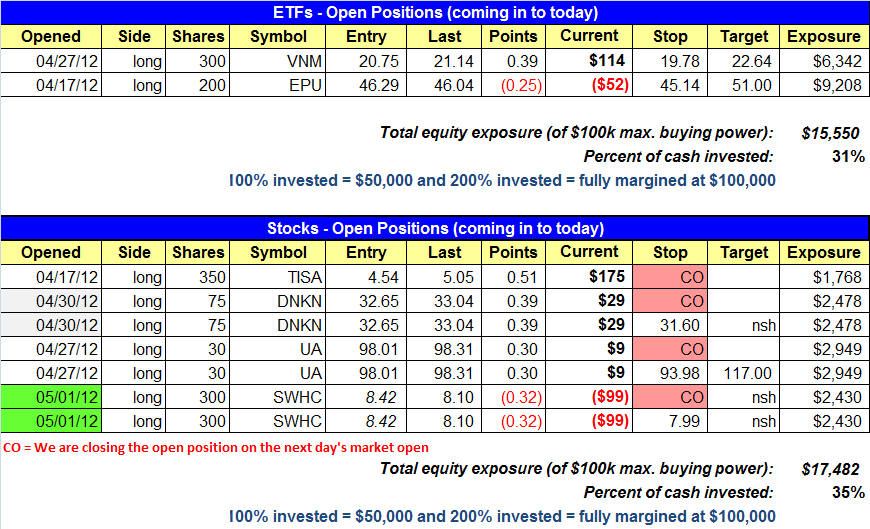
Having trouble seeing the open positions graphic above? Click here to view it directly on your web browser instead.
closed positions:

Having trouble seeing the closed positions graphic above? Click here to view it directly on your web browser instead.
ETF position notes:
- One new official setup added to the watclist in SOXS.
stock position notes:
- TISA stop triggered for 200 shares at 4.77.
- To confirm the open positions section. We are selling all of TISA (350 shares) at market on the open. Selling half of DNKN (75 shares) at market on the open. Selling half of UA (30 shares) at market on the open. Selling half of SWHC (300 shares) at market on the open.
ETF and broad market commentary:
Stocks closed mostly higher on an uptick in volume yesterday, but the rally was far from impressive. After a strong morning rally, the market tumbled into the close, leaving all five major indices well off session highs. The small-cap Russell 2000 continued its recent exhibition of relative weakness. It closed lower by 0.1%, after being up as much as 1.1% on the day. The Nasdaq clung to a 0.1% gain, while both the S&P 500 and the Dow Jones Industrial Average added 0.5%. The S&P MidCap 400 ended the session 0.4% higher.
Market internals confirmed the ugly reversal action in the averages, as both advance/decline volume ratios reversed and closed significantly off the highs of the day. The NYSE A/D volume ratio collaped from 5 to 1 in the morning to a neutral 1.1 to 1 ratio by the close. The Nasdaq A/D volume ratio also sank from a high of 6 to 1 to 2.6 to 1 at the close. Volume was higher on the Nasdaq by 15.0% and by 1.7% on the NYSE. All the major indices closed well off session highs or formed bearish reversal candles on higher volume as well. We consider this price action to be “churning,” since higher volume did not move the market to higher price levels. This is generally a sign of stealth institutional selling into strength. Consequently, we consider yesterday to be a “distribution day” for both the Nasdaq and the NYSE.
Given yesterday’s poor price action, an updated technical review of the main stock market indexes is in order. Below are charts of the S&P 500 ($SPX), Dow Jones Industrial Average ($DJIA), Nasdaq Composite ($COMPQ), small-cap Russell 2000 ($RUT), and the S&P MidCap 400 ($MID):
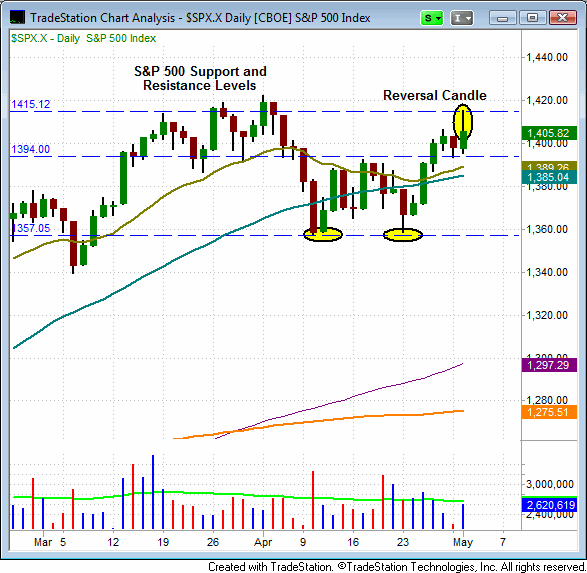
Yesterday, the S&P 500 formed a bearish reversal candle, as it found resistance at the 1,415 level. The two-day low now serves as support (1,394), with both the 20-day (the beige line) and 50-day moving average (the teal line) just below (1,385 – 1,389). The next major support is the “double bottom” formed at the 1,357 area. If the S&P loses support of its two-day low and doesn’t recover quickly, we anticipate a retest of the 1,357 swing low in the near-term. Next, take a look at support and resistance on the Dow:
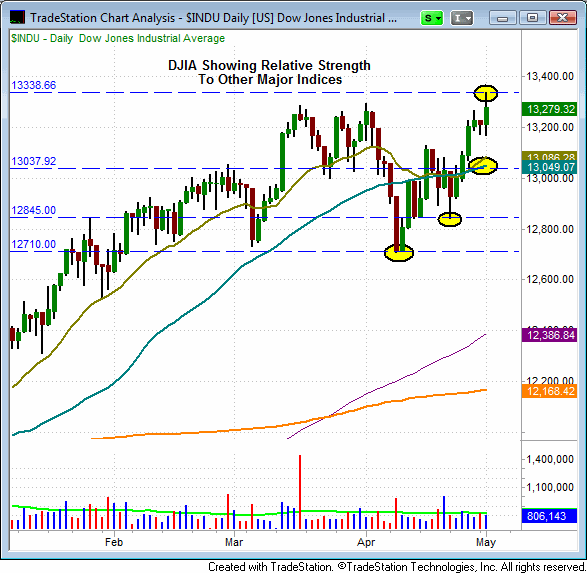
The Dow Jones Industrial Average exhibited the most relative strength yesterday, as it set a fresh 52-week closing high. However, the index also ran into difficulty because it closed well of its intraday high. The Dow should now find resistance at yesterday’s high of 13,338, and support at its two-day low (13,175 area). The next significant support level is at the 20-day EMA and 50-day MA (13,050 to 13,086 range). If the Dow loses support of these key marks, the next support level is around 12,845. Now we move on to the Nasdaq:
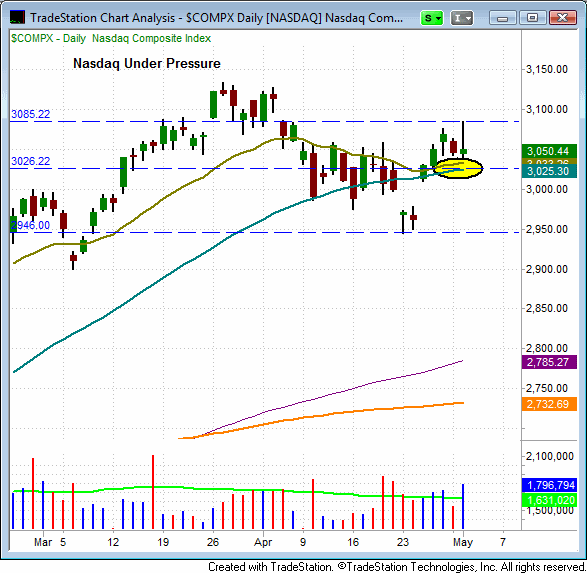
Like the Dow, yesterday’s swing high also serves as an important near-term resistance level on the Nasdaq. If the Nasdaq is unable to hold key intermediate-term support of its 50-day MA (3,025), it will likely retest the April 23rd swing low of 2,946 as its next move. Next up is the small-cap index:
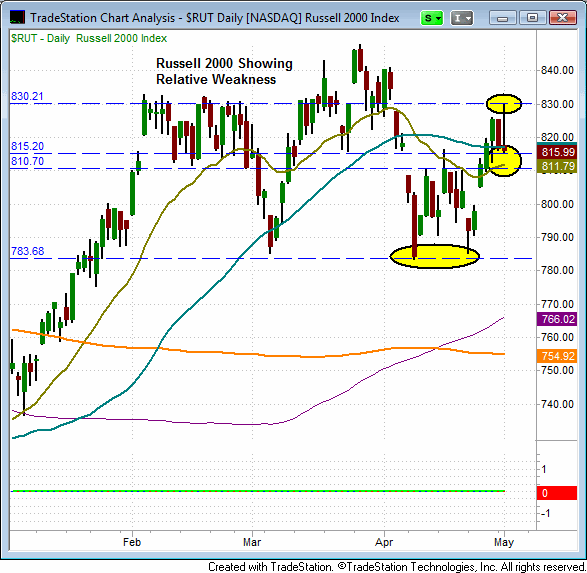
Over the past several weeks, the small-cap Russell 2000 has been the weakest of the five major indices, meaning money has been flowing out of small-cap stocks. This fact was highlighted yesterday, as the Russell was the only major index to close lower on the day. Yesterday’s high of 830 should now act as formidable resistance, while yesterday’s low (815) and the 20-day EMA (810) should serve as near-term support. If the Russell drops below the 20-day EMA, it will likely retest its most recent swing low at 783. A fourth test of the 783 mark will not likely bode well for the Russell. Last up is the mid-cap index:
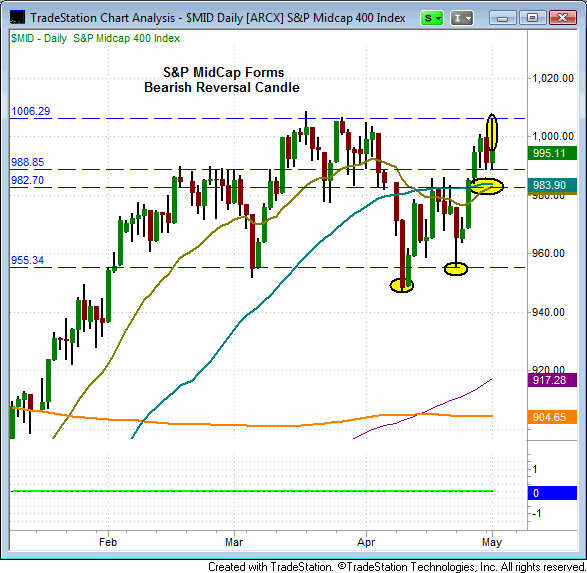
The S&P MidCap 400 reversed sharply yesterday and should now find significant resistance at yesterday’s high of 1,006. If yesterday’s low (988) is breached, the next support for the midcap index is at the 20 and 50-day moving averages. Below both of these moving averages, 955 is the next major support level for this index.
Now that you are up to speed on key near and intermediate-term support and resistance levels in the broad market, consider setting price alerts on your trading platform so that you can be instantly notified when a key level is violated. Although we stick to our disciplined trading plan by following stop prices of individual positions, not based on broad market price action, it’s also important to remember our strategy is based on trend following. As such, our market timing model continually focuses on making sure we are on the “right” side of the market at all times.”
The open ETF positions in our model portfolio held up well yesterday. Market Vectors Vietnam ($VNM) showed impressive relative strength, as it outperformed the broad market with a 1.3% gain, and settled just shy of its highest level of 2012. The iShares Peru ($EPU) “undercut” its 20-day EMA, edged a few cents higher, and closed in the upper 40% of its intraday range. In indecisive or choppy market conditions, international ETFs, such as the two we are currently positioned in, are a good way to have exposure to the stock market, but with a low correlation to the direction of the U.S. stock market indexes. Conversely, our model portfolio typically has more exposure to individual stocks, rather than ETFs, in strong and steady markets. Our market timing model determines whether current conditions are more ideal for ETFs, individual stocks, or even cash.
Overall, yesterday’s price action was concerning. The late session selloff was typical of bearish churning. With yesterday’s distribution day coming so quickly after last week’s bullish “continuation day,” there is a high probability that the market will sell off again in the next few days. We wouldn’t be surprised to see another test of the April 10th and April 23rd swing lows before the market attempts to head higher again.
stock commentary:
The data source we use to report closing volume on the NYSE was incorrect on Monday (April 30). Although we initially listed Monday’s volume in the NYSE as lighter than the prior session, volume did rise on the day (by 5%) making Monday an official distribution day on the S&P 500. When there is a distribution day within a few days of a follow through day the odds increase that the follow through day will fail (we had a follow through day in the S&P 500 on 4/25). With yesterday’s heavy volume churning at the highs, the S&P 500 now has two days of distribution in a row, which puts our market timing model in danger of registering a full sell signal. As such, we see no reason to hold on to positions with full size, so we are selling half of a few positions at the market on the open (check the open positions section for stocks with CO in the stop column). We plan to stay in a few positions with reduced share size provided that market is able to hold up. If we see continued selling action in the market we will probably close the remaining positions to limit our losses. We never want to fight the market timing model, which is now sitting at a partial sell after yesterday’s ugly reversal.
If you are a new subscriber, please e-mail [email protected] with any questions regarding our trading strategy, money management, or how to make the most out of this report.